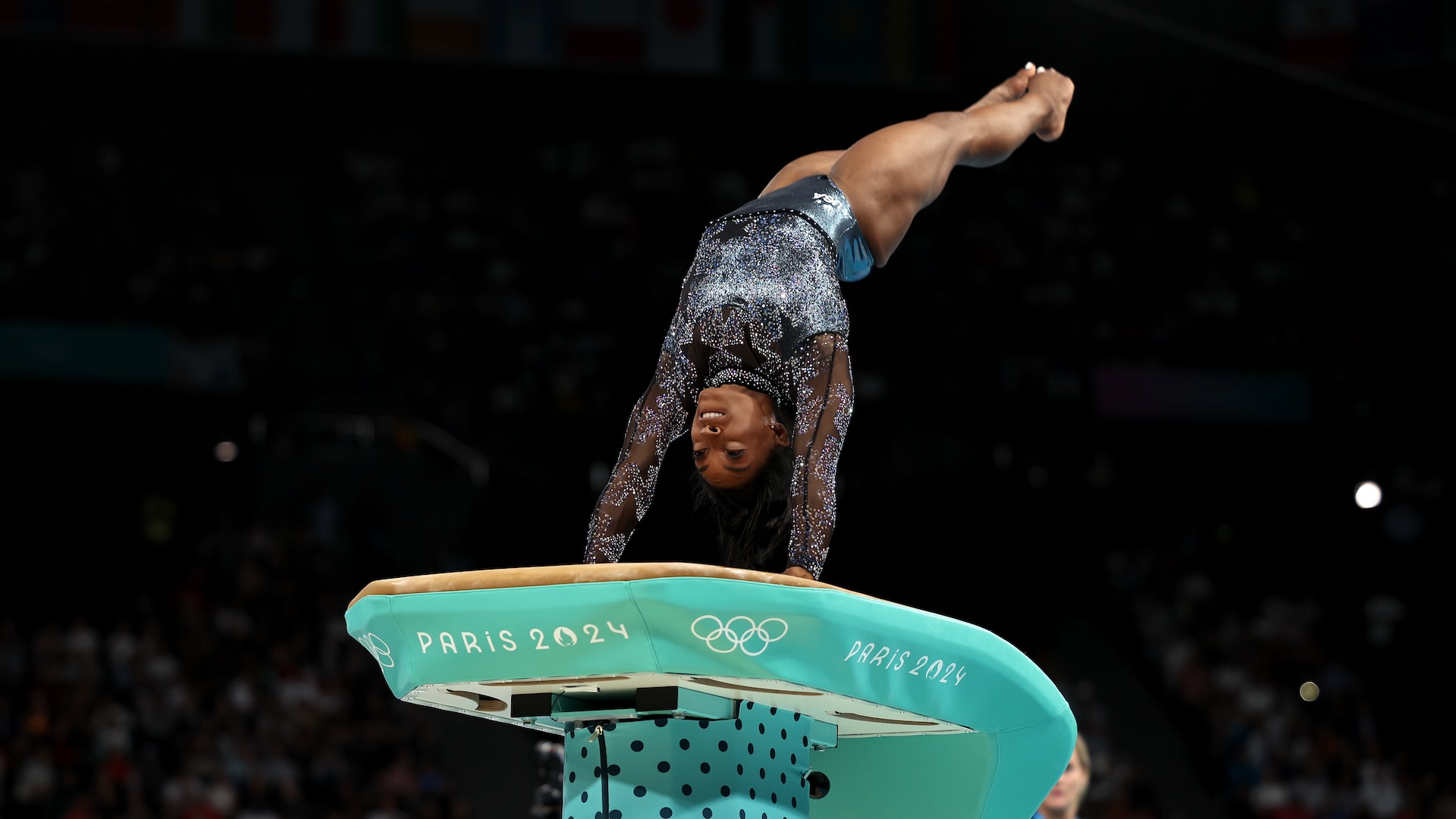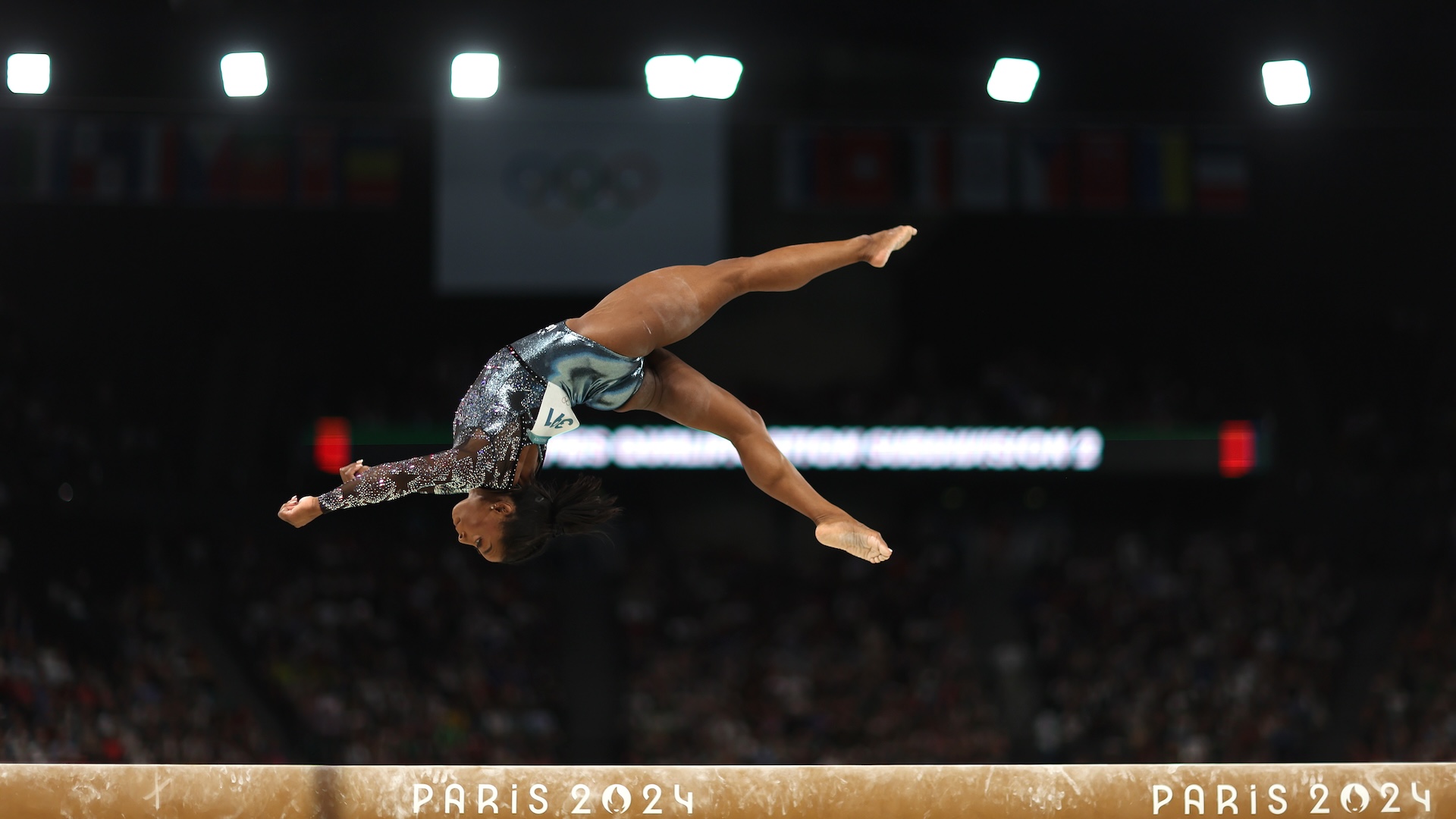
With eight Olympic medals and 30 World Championship medals under her belt — and potentially more to come soon — U.S. gymnast Simone Biles is considered one of the greatest gymnasts of all time.
So what's the science behind her success?
There's a certain "X factor" that Gina Pongetti, a former gymnast and physical therapist who is treating athletes at the 2024 Paris Olympics, calls "Simone being Simone." Beyond that, the answer lies in Biles' dedicated training of her neuromuscular system — everything from the ribbon of tissue that traverses the frontal lobe in the brain and controls movement to the sensory receptors that provide feedback to the muscles themselves.
"To be an elite athlete is one level," Pongetti told Live Science. "To step up to Simone's level involves an absolute keen understanding of her body and the input signals that come to it."
Biles stands out from other gymnasts both in terms of how she senses her body in space and how she hones her muscle memory, "as well as [her] having one of the most phenomenal bases of strength and conditioning that I've ever seen in an athlete," Pongetti added.
Related: Will Olympic athletes ever stop breaking records?
Proprioception to perfection
Biles started gymnastics at 6 years old. A youthful start is common among elite gymnasts; growing brains are adept at taking in information, said Dr. David Neuman, a fellow of the American Academy of Orthopedic Surgery and clinical director NY Sportscare in Manhattan. And that early practice, he told Live Science, often provides a basis for later adeptness.
Particularly important to gymnasts is proprioception, the sense of where one's body is in space. The sense depends on signals from specialized cells within muscles, tendons and joints. In muscles, for example, bundles of nerves called muscle spindles tell the brain how stretched or contracted a muscle is. In the skin and joints, receptors known as Pacinian corpuscles react rapidly to sensations of pressure.
When Biles competes on the vault, these corpuscles are one of her key informants as to how squarely her palms hit the apparatus and if she's effectively transferred the force she needs to launch into and twist through the air.
None of those decisions are conscious. The movements happen so quickly that the motor planning has to be preordered in advance, Pongetti explained. She compared it to a fireworks show, in which fuses of different lengths are lit at the same time. The programmed sequence is triggered when the gymnast takes their first step. In motor learning, linking together movements in this way is called "chunking," said Gregory Youdan, an independent movement scientist and dancer in New York City.
"Because it's chunked, it frees up a little bit more cognitive load for other things and allows for that automaticity," Youdan told Live Science.

Then, throughout the sequence, the proprioception system tells the athlete if all is going well. The muscles and fascia — the nerve-rich casing that covers the muscles and organs — respond accordingly with the required movements to make tiny corrections.
And that's where Biles' famous work ethic comes in. To reach that level of automaticity, gymnasts have to practice perfectly, Pongetti said. It's a stepwise process that begins in a gym's loose-foam pit, a swimming-pool-like structure filled with foam cubes where gymnasts can fall without hurting themselves. From there, the athletes slowly build up to doing the routine on the gymnastics floor, without padding.
"As each step progresses, your level of confidence should increase, thereby allowing you to take more risks of a less-forgiving landing," Pongetti said.
In a 2004 study, scientists used a sequence of finger movements — rather than gymnastic routines — to investigate how this type of memorized motor learning becomes automatic. The same brain areas lit up when people were first learning the finger movements and after they learned to do them automatically. However, brain activity declined slightly in many regions once the movement became automatic, suggesting that automaticity stems from an increase in singaling efficiency.
In 2016, researchers proposed a new theory dubbed the Optimizing Performance Through Intrinsic Motivation and Attention for Learning (OPTIMAL) theory of motor control. This suggests that honing an external focus of attention — on the outcome of the movement, rather than the precise focus on a single body part — helps to smooth this learning process.
"Athletes focus relentlessly on process and technique," said Dr. Lorenzo Norris, a psychiatrist and medical director of the George Washington University School of Medicine Resiliency & Well-being Center. Practice doesn't only make perfect; it also makes poise: By drilling skills over and over, elite athletes can stay cool and focused in stressful competitions, Norris told Live Science.
Related: 'Muscle memories' get 'zipped and unzipped' in the brain, like computer files
Muscles and mental health
Biles carries serious muscle on her 4-foot, 8-inch (1.4 meter) frame, a body type that gives her a lot of efficiency in her movements, Pongetti said. Her quickness, bestowed by fast-twitch muscle fibers that contract quickly with a burst of force, is just as important as her power.
Gymnasts also need isometric strength, which is the ability to produce force with muscle without shortening its length. This involves stiffening a muscle without moving its associated joint. That stiffness enables gymnasts to rebound off the floor or vault table, getting the air they need to execute a twist or flip.
And finally, there's the landing: At that critical moment, Pongetti said, the muscles need to absorb the force generated by all those spins and flips with an eccentric contraction, which is when the muscle contracts while lengthening. (Think of slowly lowering a dumbbell in a bicep curl, during which the bicep muscle is working hard as it's extending.)
Biles is excellent at absorbing those forces without wobbling or hopping, Pongetti said, which enables her to stick her landings neatly.
Beyond practicing the skills themselves and doing the strength and conditioning needed to execute them, elite gymnasts have to focus on flexibility, nutrition, recovery time, mental wellness, rehab for injuries, and scheduling events and competitions so as not to overtax themselves, Pongetti said. A lower-level gymnast may spend only 10% of their time thinking about those non-skills factors, she estimated, while someone like Biles might devote at least a third of their time to them.
This focus on the foundations of performance becomes increasingly important in a long career like Biles has, now competing at age 27, Pongetti added.
Another key to high performance, Norris said, is knowing when to step back. Biles famously withdrew from most events in the Tokyo Olympics in 2021 after developing the "twisties," a psychological phenomenon in which gymnasts lose their sense of where they are during flips and spins. The twisties are not only disorienting — they're dangerous, especially for gymnasts attempting particularly daring skills.
"Look at the strength it took her to step away when she knew that she needed to for her own self, and look at the strength that it took to come back again," Youdan said.
That inner strength is tough to quantify and even tougher to replicate.
"Simone is a very, very rare bird," Neuman said. "For her from such a young age to be so awesome and so elite and then go through her mental health struggles and then to come back and be one of the oldest people on the team … That's endurance and resilience right there, for her to be able to do that. That's why people love watching her."
Ever wonder why some people build muscle more easily than others or why freckles come out in the sun? Send us your questions about how the human body works to community@livescience.com with the subject line "Health Desk Q," and you may see your question answered on the website!







